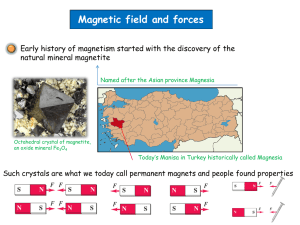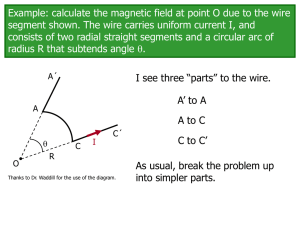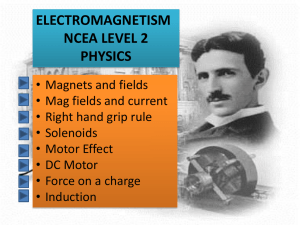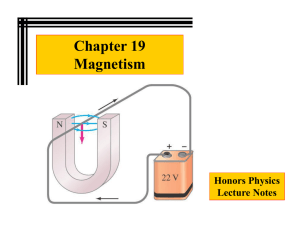ps06sol
advertisement
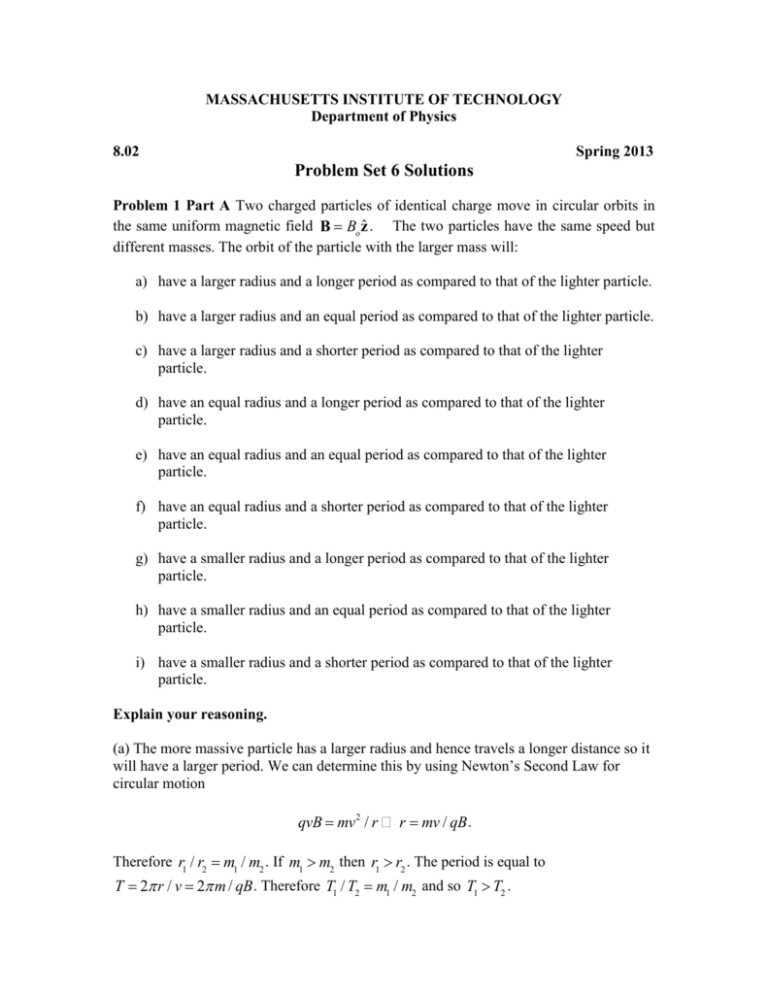
MASSACHUSETTS INSTITUTE OF TECHNOLOGY Department of Physics 8.02 Spring 2013 Problem Set 6 Solutions Problem 1 Part A Two charged particles of identical charge move in circular orbits in the same uniform magnetic field B = Bo ẑ . The two particles have the same speed but different masses. The orbit of the particle with the larger mass will: a) have a larger radius and a longer period as compared to that of the lighter particle. b) have a larger radius and an equal period as compared to that of the lighter particle. c) have a larger radius and a shorter period as compared to that of the lighter particle. d) have an equal radius and a longer period as compared to that of the lighter particle. e) have an equal radius and an equal period as compared to that of the lighter particle. f) have an equal radius and a shorter period as compared to that of the lighter particle. g) have a smaller radius and a longer period as compared to that of the lighter particle. h) have a smaller radius and an equal period as compared to that of the lighter particle. i) have a smaller radius and a shorter period as compared to that of the lighter particle. Explain your reasoning. (a) The more massive particle has a larger radius and hence travels a longer distance so it will have a larger period. We can determine this by using Newton’s Second Law for circular motion qvB = mv 2 / r Þ r = mv / qB . Therefore r1 / r2 = m1 / m2 . If m1 > m2 then r1 > r2 . The period is equal to T = 2p r / v = 2p m / qB . Therefore T1 / T2 = m1 / m2 and so T1 > T2 . Part B Course Notes: Problem 6.63(b) We want to calculate how long it takes an electron to get from a car battery to the starter motor after the ignition switch is turned. Assume that the current flowing is 115 A , and that the electrons travel through copper wire with cross-sectional area 31.2 mm 2 and length 85.5 cm . What is the current density in the wire? The number density of the conduction electrons in copper is 8.49 ´ 1028 /m3 . Given this number density and the current density, what is the drift speed of the electrons? How long does it take for an electron starting at the battery to reach the starter motor? You must you’re your work to get credit. [Ans.: 3.69 ´ 106 A/m2 , 2.71 ´ 10-4 m/s , 52.5 min .] Solution: The current density in a wire of cross sectional area A = 31.2 mm 2 carrying a current I = 115 A is J= I (115 A) = = 3.69 ´106 A × m -2 -6 2 A (31.2 ´10 m ) The current density is by definition equal to J = envd , where e is the magnitude of the charge of the electron, vd is the drift speed of the charge carriers, and n is the number of charges per unit volume. We can then solve for the drift velocity vd = I (115 A) = -19 enA (1.6 ´ 10 C)(8.49 ´ 1028 /m 3 )(31.2 ´ 10-6 m 2 ) = 2.71´10-4 m ×s -1 An electron traveling a distance d = 85.5 cm at this drift speed will take a time Dt = d 85.5 ´10-2 m = = 3.15 ´103 s1 = 52.5 min . vd 2.71´10-4 m ×s-1 Problem 2: Resistance and Conductivity (a) Resistance of Spherical Shells The region between two concentric shells is filled with a material of resistivity r r . The inner radius is ra and the outer radius is rb . What is the resistance between the shells? Solution: Suppose the shells at a positive potential difference Vab = V (a) -V (b), where the inner shell has a charge +Q and the outer shell has charge -Q . By Gauss’s Law, the electric field between the shells points outward and has magnitude E= kQ . r2 The potential difference between the shells is then ra æ 1 1ö kQ dr = kQ ç - ÷ . 2 r è ra rb ø rb Vab = V (a) -V (b) = - ò The current between the shells is I= òò J × n̂ dA = open surface = (1/ rr ) òò òò (1/ rr )E × n̂ dA open surface E dA = (1/ rr )EA = (1/ rr ) shell of radius r kQ 4p kQ . 2 4 p r = rr r2 The resistance between the shells is by definition æ 1 1ö kQ ç - ÷ V è ra rb ø rr æ 1 1 ö rr æ rb - ra ö . R = ab = = = 4p kQ I 4p çè ra rb ÷ø 4p çè ra rb ÷ø rr In the limit that rb - ra << ra , the resistance becomes R rr æ rb - ra ö rr L = 4p çè ra 2 ÷ø A where A = 4p ra 2 is the area and L = rb - r is the length, agreeing with our result for a cylindrical resistor. (b) Resistance of Conductor in Telegraph Cable The first telegraphic messages crossed the Atlantic Ocean in 1858, by a cable 3000 km long laid between Newfoundland and Ireland. The conductor in this cable consisted of seven copper wires, each of diameter 0.73 mm, bundled together and surrounded by an insulating sheath. Calculate the resistance of the conductor. Use 3 108 Ω m for the resistivity of copper, which was of somewhat dubious purity. Solution: When current flows in the cable, the ends of each of the seven copper wires are held at the same voltage difference, so the wires are in parallel. Recall that when resistors are in parallel, the equivalent resistance adds inversely: 1 1 1 . Req R1 R2 Since resistance is inversely proportional to area, we have that A A 1 1 1 1 2 . Req R1 R2 L1 L2 The wires are all the same length and area so for seven wires 1 7A . Req L Thus the equivalent resistance is Req L 7A (3 108 Ω m)(3 106 m) 3.0 104 . (7)( )(7.3 104 m / 2)2 Check: Since resistance is inversely proportional to area, the effective area is seven times the area of one wire. (c) Non-uniform Conductivity A cylindrical glass rod is heated with a torch until it conducts enough current to cause a light bulb to glow. The rod has a length L = 2.0 cm , a diameter d = 0.5 cm , and its ends, plated with material of infinite conductivity, are connected to the rest of the circuit. When red hot, the rod’s conductivity varies with position x measured from the center of the rod as s (x) = s 0 L2 / x 2 , with s 0 = 4 ´ 10-2 (Ω × m)-1. a) What is the resistance of the glass rod? Express your answer both symbolically and as a value in ohms. b) When a voltage DV is applied between the two ends, what is the current density J ( x) ? c) What is the steady-state electric field E( x) ? Solutions: (a) We shall consider a small slice of the rod of thickness dx located a distance x measured from the center of the rod. The resistance dR of this small section is given by r dx dx 4x 2 dx . dR = r = = A s c A s 0 L2p d 2 The total resistance of the rod is then the integral over the whole rod since these small sections can be thought of as in series, L/2 L/2 4x 2 dx 4x 3 R = ò dR = ò = 2 2 3s 0 L2p d 2 - L/2 - L/2 s 0 L p d L/2 = - L/2 L 3s 0p d 2 . (2 ´10-2 m) R= = 2.1´103 W -2 -1 -2 2 (3)(4 ´10 (Ω × m) )(p )(0.5 ´10 m) b) The current density is given by J(x) = I 4DV 12s 0 DV = = A Rp d 2 L This is independent of the position in the rod. c) The electric field is given by J(x) 12s 0 DV / L 12DV 2 E(x) = = î = x î . s s 0 L2 / x 2 L3 Problem 3: Magnetic Field Definition You are trying to determine the magnetic field in a region where you know that the electric field is zero (a test charged object at rest feels no force).. You begin by taking a positive test charge with charge qt that is moving along the positive x-axis with velocity v1 = v1 î . At a point P along the x-axis with position rP = (xP ,0,0) . You measure the force on the test charge and find that F1 = F1k̂ with F1 > 0 . You now send your test charge in the x-y plane at an angle a with the positive x-axis ( 0 < a < p ) with velocity v 2 = v2 cos a î + v2 sin a ĵ , v2 > 0 You now measure the force and find that F2 = F2 k̂ with F2 > 0 . Find a vector description of the magnetic field at the point P . Express your answer in terms of F1 , F2 , v1 , v2 , qt , and a as needed. Solution: Because F1 = qt v1 ´ B , the magnetic field is perpendicular to the force and hence lies in the x-y plane. Let B = Bcosq î + Bsinq ĵ where q is the angle B makes with the positive x-axis. Then F1k̂ = qt v1 î ´ B = qt v1 î ´ (B cosq î + Bsin q ĵ) = qt v1 Bsinq k̂ Thus F1 = qt v1 Bsinq (0.1) Similarly F2 k̂ = qt (v2 cos a î + v2 sin a ĵ) ´ (B cosq î + Bsinq ĵ) = (qt v2 cos a Bsin q - qt v2 sin a B cosq )k̂ Thus F2 = qt v2 cos a Bsinq - qt v2 sin a Bcosq we can now divide Eq. (0.2) by Eq. (0.1) yielding (0.2) F2 qt v2 cos a Bsin q - qt v2 sin a B cosq v2 cos a v2 sin a cotanq = = F1 qt v1 Bsinq v1 v1 (0.3) We can solve Eq. (0.3) for cotanq cotanq = 1 æ v1F2 ö cos a sin a çè v2 F1 ÷ø (0.4) Thus æ 1 æ v F öö cos a - 1 2 ÷ ÷ ç v2 F1 ø ø è sin a è q = cotan-1 ç (0.5) We can now use Eq. (0.1) to find the magnitude of B , B= F1 qt v1 sin q (0.6) So using Eqs. (0.6) and (0.4) we now have our vector description of the magnetic field the magnetic field B = Bcosq î + Bsinq ĵ B = B(cos q î + sin q ĵ) F1 (cosq î + sin q ĵ) qt v1 sin q F = 1 cotanq î + ĵ qt v1 = ( B= ) ö F1 æ 1 æ v1F2 ö cos a î + ĵ ÷ qt v1 çè sin a çè v2 F1 ÷ø ø (0.7) Problem 4: Hall Effect A current I flows to the right through a rectangular bar of conducting material with dimensions shown on the figure below in the presence of a uniform magnetic field B pointing out of the page. a) If the moving charges are positive, in which direction are they deflected by the magnetic field? This deflection results in an accumulation of charge on the upper and lower surfaces of the bar, which in turn produces an electric field and electric force on the moving charges to counteract the magnetic force. Equilibrium occurs when the two exactly cancel. (This phenomenon is known as the “Hall effect”). b) Find the resulting potential difference between the top and bottom of the bar in terms of the magnitude of the magnetic field B , the drift speed of the charges v , and the relevant dimensions of the bar. c) How would your analysis change if the moving charges were negative? Solution: Choose coordinates as shown in the figure below. Suppose the current consists of positive ions. Then the average velocity of the charge carriers is in the positive y-direction v q = vq ĵ . Then the force on a charge carrier is given by Fmag = qv ´ B = qvq ĵ ´ Bî = -qvq Bk̂ The force is downward and so positive charges accumulate on the lower surface and negative charges accumulate on the upper surface producing an upward electric field and upward electric force on the charge carriers balancing the magnetic force and “equilibrium” occurs when the two exactly cancel. Suppose a surface charge density +s and +s appears on the lower and upper surfaces respectively. Then by Gauss’s Law a constant electric field E= s k̂ = Ek̂ e0 appears between the plates. The potential difference is then lower DV º V(lower) - V (upper) = - ò E × ds = Et upper where t is the thickness of the slab. When equilibrium is reached qE + Fmag = qEk̂ - qvq Bk̂ = 0 . Thus E = vq B and the potential difference between the plates is DV = vq Bt . Suppose the current consists of positive ions. Then the average velocity of the charge carriers is in the negative y-direction v q = -vq ĵ . Then the force on a charge carrier is given by Fmag = qv ´ B = -qvq ĵ ´ Bî = +qvq Bk̂ Because q < 0 , this force is also downwards and so now the bottom surface is negatively charged and the top surface positively charged reversing the sign of electric field E = -Ek̂ and hence also reversing the sign of the potential difference lower DV º V(lower) - V (upper) = - ò E × ds = -Et = -vq Bt . upper Thus the sign of the Hall potential difference determines the sign of the charge carriers. Problem 5: Magnetic Force on a Current Carrying Wires (a) Levitating Wire A copper wire of diameter d carries a current density J at the earth’s equator where the earth’s magnetic field is horizontal, points north, and has magnitude Bearth = 0.5 ´10-4 T . The wire lies in a plane that is parallel to the surface of the earth and is oriented in the east-west direction. The density of copper is Cu 8.9 103 kg m -3 . The resistivity of copper is r 1.7 108 Ω m . i) How large must J be, and which direction must it flow in order to levitate the wire? Use g 9.8m s-2 ii) When the wire is floating how much power will be dissipated per cubic centimeter? Solution: At the equator, the magnetic field is pointing north. Choose unit vectors such that î points east, ĵ points north, and k̂ points up. Let J = J x î (with the sign of J x to be determined), Bearth = Bearth ĵ . . Then the magnetic force dFmag on the a small volume of wire dVvol is dFmag = JdVvol ´ Bearth = J x dVvol î ´ Bearth ĵ = J x Bearth dVvol k̂ . (0.8) In order to balance the gravitational force this must point upwards hence J x 0 ; the current flows from west to east in the wire. The total force on the small element of the wire is zero so 0 = dFgrav + dFmag = rCu dVvol g(- k̂) + J x Bearth dVvol k̂ . We can solve Eq. (0.9) for J x : (0.9) Jx Cu g Bearth (8.9 103 kg m -3 )(9.8 m s -2 ) Jx 1.74 109 A m -2 -4 (0.5 10 T) . (0.10) (b) Let A (d / 2)2 denote the cross-sectional area of the wire. The power dissipated per volume dVvol Adl where dl is a unit length of wire is given by P I 2R . dVvol dVvol (0.11) . The current through the wire is given by is given by I J x A . The resistance per unit length dl is given by R r dl / A . So Eq. (0.11) becomes (J x A)2 ( rr dl / A) P = = rr J x 2 dVvol Adl = (1.7 ´ 10 -8 Ω × m)(1.74 ´ 109 A × m -2 )2 . = (5.2 ´ 1010 W × m -3 ) 50 kW ×cm -3 The wire will get very hot! (0.12) (b) Force on a Current Carrying Loop of Wire A wire of arbitrary shape, which is confined to the x-y plane, carries a current I from point A to point B in the plane. Show that if a uniform magnetic field B perpendicular to the x-y plane is present, the force that the wire experiences is the same as that which would be felt by a wire running straight from A to B. Solution: Let’s assume that the horizontal distance between A and B is s and the vertical distance between A and B is d. Then for the straight line path L = sî + dĵ . The force on the straight wire with current I is then Fstraight = IL ´ B . wire For the curved wire ds = dx î + dy ĵ and the force on the wire is Fwire = ò ( I ds ´ B) = ò ( I (dx î + dy ĵ) ´ B) . wire wire When the magnetic field is uniform, both I and B can be pulled out of the integral and the force on the wire becomes Fwire = ò ( I ds ´ B) = I[ ò wire (dx î + dy ĵ)] ´ B wire We can calculate each integral separately Fwire = I[ ò wire dx î ] ´ B + I[ ò dy ĵ] ´ B = Is î ´ B + Idĵ ´ B = IL ´ B , wire which is equal to the force on the straight wire connecting the same two end points A and B. (c) Charge flowing in a Wire A U-shaped wire of mass m has its ends immersed in two jars of mercury which are separated by a distance l . The wire is in uniform magnetic field B perpendicular to the plane of the wire. A very fast current pulse is passed through the wire and in response the wire jumps upward a height h . How large was the charge Q = ò Idt , which passed through the wire. You may want to use the results of the previous part a). You may ignore the effect of the gravitational field while the current pulse runs through the wire. Solution: While the ends of the wire are in the jars and a current is flowing through the wire there are two forces acting on the wire, a magnetic force and a gravitational force. This causes the wire to accelerate upwards for a time t until the ends leaves the jar. At that instant the wire has some speed v1 upwards and hence kinetic energy. The wire jumps to a height h and converts that kinetic energy into potential energy 1 mv12 = mgh . 2 Thus the speed at the instant the ends leave the jars is v1 = 2gh . Using our result from part a) that the force on the current carrying wire in the uniform magnetic field is equal to the force on a current carrying wire that makes a straight path l between the jars in the magnetic field, we find that Fwire = I l ´ B . We choose coordinates as shown in the figure below. Then the magnetic force on the wire is given by Fwire = I l ´ B = I l î ´ B (-k̂) = I l B ĵ . The impulse due to both the magnetic and gravitational forces causes the momentum of the wire to change. Thus mv1 = ò t=Dt t=0 (Fmag - Fgrav )dt = ò t=Dt t=0 (IlB - mg)dt = (IlB - mg)Dt . So the time interval in the jar is given by Dt = mv1 . IlB - mg Therefore the charge flowing through the wire during this interval is then Q=ò t=Dt t=0 I dt = IDt = Im 2gh Imv1 . = IlB - mg IlB - mg If we ignore the effect of the gravitational force during the impulse then Q= m 2gh . lB Problem 6: Cyclotron The cyclotron (figure below) is a device used to accelerate elementary particles such as protons to high speeds. Particles start at point A with some initial velocity and travel in circular orbits in the magnetic field B. The particles are accelerated to higher speeds each time they pass in the gap between the metal “Dees,” where there is an electric field E. (There is no electric field within the cavity of the metal Dees.) The electric field changes direction each half-cycle, owing to an ac voltage V = V0 sin 2p ft , so that the particles are increased in speed at each passage through the gap. a) Show that the frequency f of the voltage must be f = Bq / 2p m , where q is the charge on the particles and m their mass. b) Show that the kinetic energy of the particles increases by 2qV0 each revolution, assuming the gap is small. c) If the radius of the cyclotron is 2.0 m and the magnetic field strength is 0.50 T, what will be the maximum kinetic energy of accelerated protons in MeV? Solution: a) Let’s assume that we are accelerating protons, q e . In the figure, we show the proton after it has just completed a semi-circular orbit of radius r . The proton experiences an inward force throughout the semi-circular orbit due to the uniform magnetic field. The force at the moment shown in the figure is ( ) F = e -vk̂ ´ Bĵ = evBî . (0.13) . The acceleration is a = v 2 / r î . Newton’s Second Law becomes 2 mv ˆ evBˆi i. r (0.14) We can solve for the velocity and find that v eBr / m . (0.15) . The particle travels half the circumference in a time that is half the period T of a full circular orbit. Therefore vT / 2 r . (0.16) . So using our result for the velocity we can find that the period is T 2 r / v 2 m / eB . (0.17) . The frequency is defined to be the inverse of the period, f 1/ T eB / 2 m . (0.18) The change in kinetic energy is Kdee U eV 0 . Remember that the positive charge always moves from higher electric potential to lower electric potential, V 0 . If the potential is timed such that sin(2p ft) = 1 then the voltage difference is V V0 . Here we are assuming that the time that it takes to cross the 'dees' is small compared to the period of the orbit. Thus the proton increases its kinetic energy by a factor of Kdee eV0 for each crossing. Since it crosses the 'dees' twice for each period of its orbit, it picks up a change of potential energy K one orbit 2eV0 . (0.19) d) If we assume the last orbit has radius, the radius of the cyclotron, then the velocity after the last semi-circle is v f eBR / m . So the final kinetic energy is (0.20) 1 1 e2 B 2 R 2 . K f mv f 2 m(eBR / m)2 2 2 2m (0.21) . The charge of the proton is e = 1.6 ´10-19 C . The mass of a proton is m = 1.67 ´10-27 kg . So the final kinetic energy is (note: 1 Mev = 1´106 ev , and 1ev = 1.6 ´10-19 J ), (1.6 ´10-19 C)2 (5.0 ´10-1 T)2 (2.0 m)2 1ev Kf = = (7.7 ´10-12 J) = 48 Mev -27 2(1.67 ´10 kg) 1.6 ´10-19 J (0.22). Problem 7: Magnetic fields of Current Loops (a) Find the magnetic field at point P due to current loop shown in the figure below. Solution: (b) There is no magnetic field sue to the straight segments because point P is along the lines. Using the general expression for dB obtained in (a), for the outer segment, we have p æm Iö m0 Idq k̂ = ç 0 ÷ k̂ 4p b è 4b ø 0 B out = ò Similarly, the contribution to the magnetic field from the inner segment is 0 B in = ò p æm Iö m0 Idq k̂ = - ç 0 ÷ k̂ 4p a è 4a ø Therefore the net magnetic field at Point P is B net = B out + B in = - m0 I æ 1 1 ö - k̂ 4 çè a b ÷ø (b) Force and Torque on a Current Loop A current loop consists of a semicircle of radius R and two straight segments of length s with an angle q between them. The loop is then placed in a uniform magnetic field pointing to the right, as shown in the figure below. (a) Find the net force on the current loop. (b) Find the net torque on the current loop. Solution: (a) The force on the current loop is zero because the magnetic field is uniform Fwire = ò (I ds ´ B) = ò (I ds) ´ B wire The integral wire ò (I ds) = 0 because we begin and end at the same point. Therefore wire Fwire = ò (I ds) ´ B = 0 wire The torque on a current loop is given by where the magnetic moment is given by m = IAn̂ RHR . For the current loop shown in the figure above the area is A = (1 / 2)p R2 + s 2 cos(q / 2)sin(q / 2) = (1 / 2)(p R2 + s 2 sin(q )) . With coordinates shown in the figure above, the current is clockwise so n̂ RHR = - k̂ . B = Bî . Therefore the torque is . Problem 8: Helmholtz Coils Consider two N-turn circular coils of radius R, each perpendicular to the axis of symmetry, with their centers located at z = ± l / 2 . There is a steady current I flowing in the same direction around each coil, as shown in the figure below. a) Find the magnetic field Bon the axis at a distance z from the midpoint between the centers of the two coils. b) Show that when l = R the second derivative of Bz vanishes at the center of the two coils, i.e. at z = 0. That is, the distance of separation between the two coils is equal to the radius of the coil. A configuration of coils with l = R is known as Helmholtz coil. Solution: (a) We shall use the Biot-Savart law to find the magnetic field on the symmetry axis of a single loop. (1) Source point In Cartesian coordinates, the differential current element located at r ' = R(cos f ' ˆi + sin f ' ˆj) can be written as Ids = I (dr '/ df ')df ' = IRdf '(- sin f ' ˆi + cos f ' ˆj) . (2) Field point Since the field point P is on the axis of the loop at a distance z from the center, its position vector is given by r = zk̂ . (3) Relative position vector r - r ' The vector form the current element ot the field point is given by r - r ' = -Rcos f ' î - Rsin f ' ĵ + z k̂ (23) ( (24) and its magnitude ) 2 r = r - r ' = (-Rcos f ')2 + -Rsin f ' + z 2 = R2 + z 2 is the distance between the differential current element and P. Thus, the corresponding unit vector from Id s to P can be written as r̂ = r - r' |r - r' | (4) Simplifying the cross product The cross product d s ´ (r - r ') can be simplified as d s ´ (r - r ') = R df '(- sin f ' î + cos f ' ĵ) ´ (- Rcos f ' î - Rsin f ' ĵ + z k̂) = R df '(z cos f ' î + z sin f ' ĵ + R k̂) (25) (5) Writing down dB Using the Biot-Savart law, the contribution of the current element to the magnetic field at P is m0 I d s ´ r̂ m0 I d s ´ (r - r ') = 4p r 2 4p | r - r ' |3 m IR z cos f ' î + z sin f ' ĵ + R k̂ = 0 df ' 4p (R 2 + z 2 )3/ 2 dB = (6) Carrying out the integration Using the result obtained above, the magnetic field at P is (26) m0 IR 2p z cos f ' î + z sin f ' ĵ + R k̂) ( df ' 4p ò0 (R2 + z 2 )3/ 2 B= (27) The x and the y components of Bcan be readily shown to be zero: Bx = By = m0 IRz 4p ( R 2 + z 2 )3/ 2 m0 IRz 4p ( R + z ) 2 2 3/ 2 ò 2p 0 ò 2p 0 cos f ' df ' = sin f ' df ' = - m0 IRz 4p ( R 2 + z 2 ) sin f ' 3/ 2 m0 IRz 4p ( R + z ) 2 2 3/ 2 2p 0 cos f ' 2p 0 =0 =0 (28) (29) On the other hand, the z component is Bz = 2p m0 m0 2p IR 2 m0 IR 2 IR 2 d f ' = = 4p ( R 2 + z 2 )3/ 2 ò0 4p ( R 2 + z 2 )3/ 2 2( R 2 + z 2 )3/ 2 (30) Thus, we see that along the symmetric axis, Bz is the only non-vanishing component of the magnetic field. The conclusion can also be reached by using the symmetry arguments. The behavior of Bz / B0 where B0 = m0 I / 2 R is the magnetic field strength at z = 0 , as a function of z / R is shown in the figure below. Consider two N-turn circular coils of radius R, each perpendicular to the axis of symmetry, with their centers located at z = ± l / 2 . There is a steady current I flowing in the same direction around each coil, as shown in the figure below. Find the magnetic field Bon the axis at a distance z from the center of one coil. We shall use our result for a single coil and multiply by the number of turns N and then apply the superposition principle, to find the magnetic field at P(0,0, z) , The point P is a distance z - l / 2 away from the center of the upper coil and z + l / 2 from the center of the lower coil). Bz = Bz,top + Bz,bot = m0 NIR2 é A plot of Bz / B0 with B0 = 2 ù 1 1 + ê 2 2 3/ 2 2 2 3/ 2 ú [(z + l / 2) + R ] û ë [(z - l / 2) + R ] m0 NI (5 / 4)3/ 2 R depicted in the figure below. (1) being the field strength at z = 0 and l = R is b) Show that when l = R the second derivative of Bz vanishes at the center of the two coils, i.e. at z = 0. That is, the distance of separation between the two coils is equal to the radius of the coil. A configuration of coils with l = R is known as Helmholtz coil. Solution: Differentiating Bz with respect to z, we obtain Bz¢ ( z ) = dBz m0 NIR 2 = dz 2 ì ü 3( z - l / 2) 3( z + l / 2) í2 2 5/ 2 2 2 5/ 2 ý [( z + l / 2) + R ] þ î [( z - l / 2) + R ] (2) One may readily show that at the midpoint, z = 0 , the derivative vanishes: dB dz =0 (3) z =0 The second derivative is then 2 d 2 B N m0 IR ïì 3 15(z - l / 2)2 = + í 2 2 5/ 2 2 dz 2 [(z - l / 2)2 + R 2 ]7 / 2 îï [(z - l / 2) + R ] - üï 3 15(z + l / 2)2 + 2 2 5/ 2 2 2 7/2 ý [(z + l / 2) + R ] [(z + l / 2) + R ] þï (4) At the midpoint z = 0, the above expression simplifies to Bz¢¢(0) = d 2B dz 2 =- = z =0 m0 NI 2 2 m0 NI 2 ì 2 ü 6 15l 2 + í 2 2 5/ 2 2 2 7/2 ý 2[(l / 2) + R ] þ î [(l / 2) + R ] 6( R 2 - l 2 ) [(l / 2) 2 + R 2 ]7 / 2 (5) Thus when l = R the second derivative of Bz vanishes at z = 0. Note: For small z, we may make a Taylor-series expansion of Bz ( z ) about z = 0 : Bz ( z ) = Bz (0) + Bz¢ (0) z + 1 Bz¢¢(0) z 2 + ... 2! (6) The fact that the first two derivatives vanish at z = 0 indicates that the magnetic field is fairly uniform in the small z region. One may even show that the third derivative Bz¢¢¢(0) vanishes at z = 0 as well.


